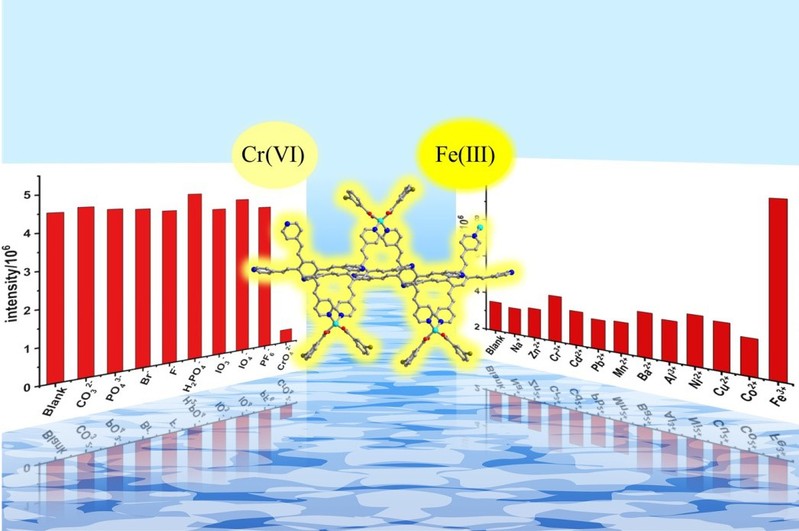Assembly of a Zn(ii) coordination polymer of tetrapyridyl tetraene ligands for selective sensing of CrO42− and Fe3+ in water via luminescence quenching and enhancement
Zhan-Yong Yang , Chen Cao , Xiao Sang , Yu-Xuan Hong , Hong Yu , Chun-Yan Ni , Jian-Ping Lang

Four Zn(II)-based coordination polymers (CPs), [Zn(4-tkpvb)(FB)2] (CP1), [Zn(4-tkpvb)(CB)2] (CP2), [Zn(4-tkpvb)(BB)2] (CP3) and [Zn(4-tkpvb)(NTP)]n (CP4), were prepared from solvothermal reactions of Zn(NO3)2·6H2O with 1,2,4,5-tetrakis((E)-2-(pyridin-4-yl)vinyl)benzene (4-tkpvb) in the presence of 3-fluorobenzoic acid (HFB), 3-chlorobenzoic acid (HCB), 3-bromobenzoic acid (HBB) and nitroterephthalic acid (H2NTP). These four compounds were structurally characterized by IR, elemental analysis, powder X-ray diffraction and single-crystal X-ray diffraction. CP1–CP3 have similar one-dimensional (1D) zigzag chain structures assembled by 4-tkpvb connecting the [ZnL2] (L = FB, CB, BB) units. CP4 displays an unusual 6-fold interpenetrating three-dimensional (3D) net with a ‘dia’ topology formed by linking the 2D [Zn(NTP)(4-tkpvb)]n layers via 4-tkpvb ligands. CP1–CP4 all exhibited luminescence emission in the solid state. The representative CP3 exhibited good water stability in the pH range from 3 to 13. It was revealed to be an intriguing luminescent probe for CrO42− anions in H2O by a selective fluorescence quenching method or Fe3+ ions in H2O by selective fluorescence enhancement. The detection limit was 0.679 ppm for CrO42− or 0.429 ppm for Fe3+. The emission quenching process may be ascribed to the overlap between the absorption band of the CrO42− anion and those of the excitation and/or emission bands of CP3, while the emission enhancement mechanism was likely due to the weak interaction between Fe3+ and the uncoordinated pyridyl group in CP3.
组装四吡啶基四烯配体的 Zn(II) 配位聚合物,通过发光猝灭和增强选择性检测水中的 CrO42- 和 Fe3+
四种 Zn( II ) 基配位聚合物 (CP)、[Zn(4-tkpvb)(FB) 2 ] ( CP1 )、[Zn(4-tkpvb)(CB) 2 ] ( CP2 )、[Zn(4- tkpvb)(BB) 2 ] ( CP3 ) 和 [Zn(4-tkpvb)(NTP)] n ( CP4 ) 由 Zn(NO 3 ) 2 ·6H 2 O 与 1,2,4 的溶剂热反应制备,在 3-氟苯甲酸( HFB )、3-氯苯甲酸 (HCB)、3-溴苯甲酸 ( HBB) 和硝基对苯二甲酸 (H 2NTP)。通过红外光谱、元素分析、粉末X射线衍射和单晶X射线衍射对这四种化合物进行了结构表征。CP1 – CP3具有相似的一维 (1D) 锯齿形链结构,由连接 [ZnL 2 ] (L = FB, CB, BB) 单元的 4-tkpvb 组装而成。CP4展示了一个不寻常的 6 重互穿三维 (3D) 网络,其具有通过4-tkpvb 配体连接 2D [Zn(NTP)(4-tkpvb)] n层形成的“直径”拓扑。CP1 – CP4在固态都表现出发光。代表CP3在 3 到 13 的 pH 值范围内表现出良好的水稳定性。通过选择性荧光猝灭法发现它是H 2 O 中的 CrO 4 2-阴离子或通过选择性荧光发现 H 2 O中的Fe 3+离子的一种有趣的发光探针增强。CrO 4 2-的检测限为 0.679 ppm或 Fe 3+的检测限为 0.429 ppm 。发射猝灭过程可能归因于CrO 4 2-阴离子的吸收带与CP3的激发和/或发射带之间的重叠,而发射增强机制可能是由于Fe 3+之间的弱相互作用和CP3中未配位的吡啶基。
DOI: 10.1039/d1ce01706c

